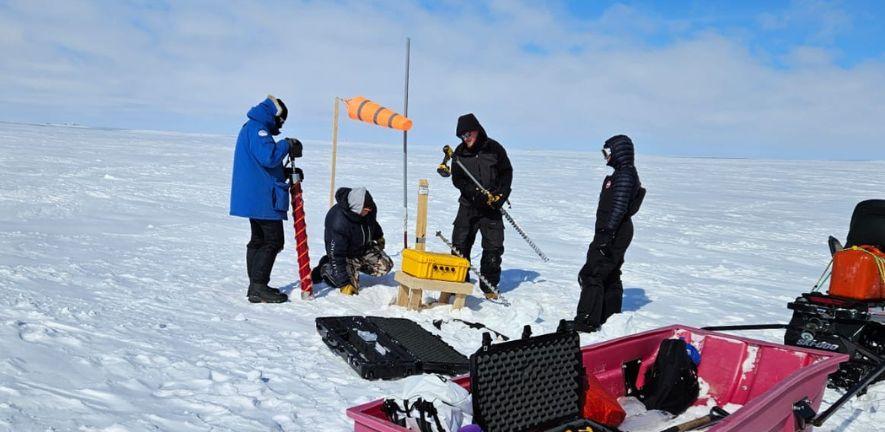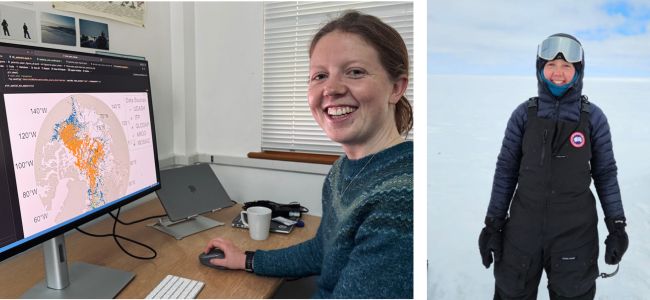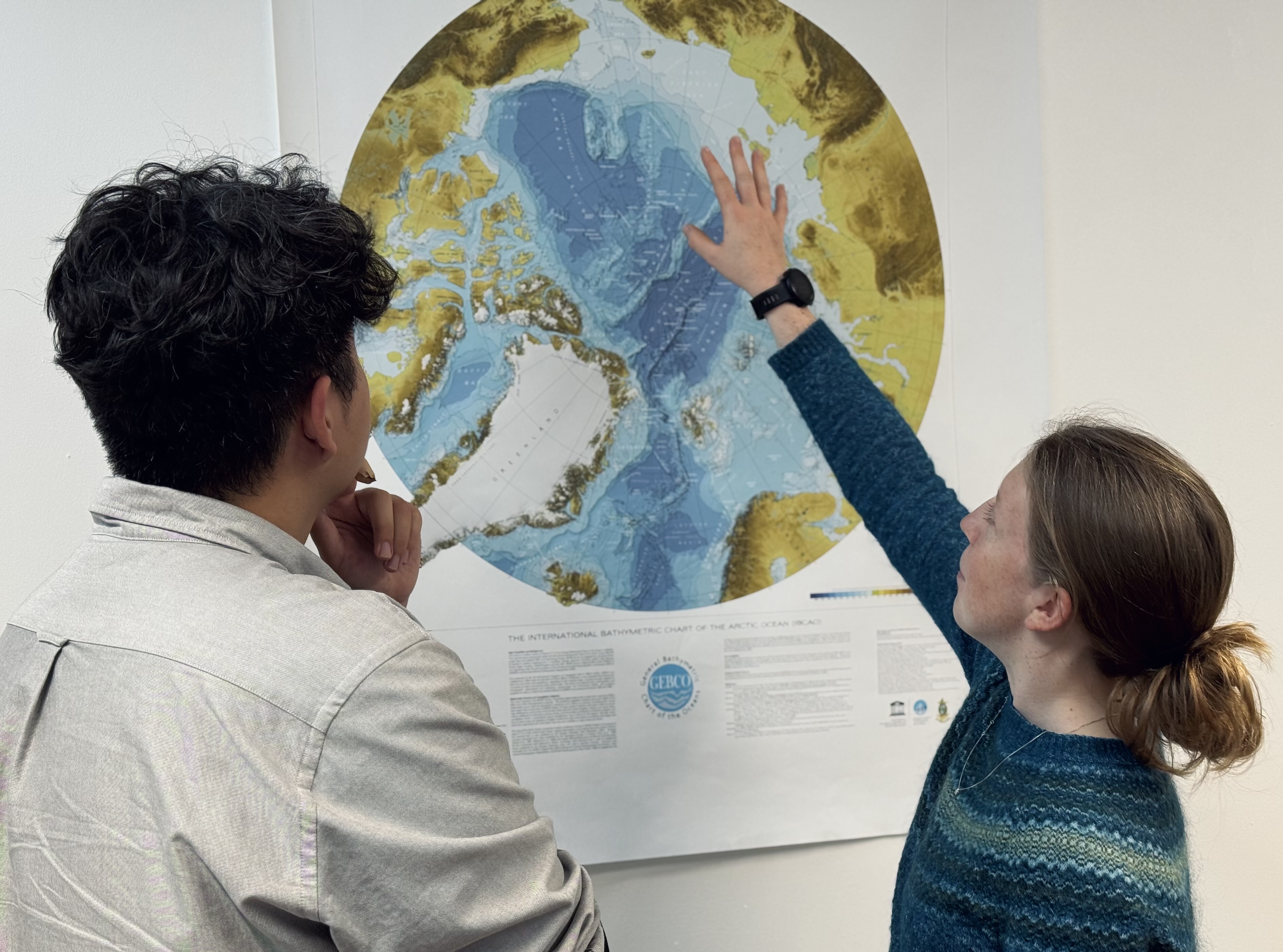
Submitted by Dr C.M. Martin-Jones on Wed, 15/10/2025 - 16:41
As her plane approached Victoria Island in Nunavut, Canada, Kate Oglethorpe caught her first glimpse of the white and expansive Arctic, and the study region of her PhD.
Normally Oglethorpe studies the Arctic Ocean from her desk at Cambridge’s Department of Earth Sciences, where she uses publicly available ocean data to examine how the region's ocean currents are changing as the climate warms.
On her first expedition to the high Arctic, Oglethorpe was working outside of her usual scientific wheelhouse, joining a team of scientists, engineers and local guides testing an experimental method to restore dwindling sea ice.
The fieldwork, led by the UK company Real Ice as part of a project co-ordinated by Cambridge's Centre for Climate Repair, is exploring whether the retreat of Arctic sea ice can be slowed by artificially thickening it. Working at a test site in Cambridge Bay, the researchers are pumping seawater up through the sea ice and onto its surface where it freezes in winter.
Earlier this year, the team returned to the site, spending a week in freezing temperatures of around -15°C, to collect measurements of snow and ice thickness and check on their ongoing experiment.
Oglethorpe joined the Real Ice team in the field, “it’s a fascinating and very experimental project—something I never thought I’d take part in,” she said.
“Working alongside the field team and seeing their dedication to science in such freezing conditions was really inspiring.”
The team is working closely with the Inuit community of Cambridge Bay, whose livelihoods, culture, and resources depend on the sea ice.
Kate swapped her desk in Cambridge for fieldwork in the Arctic.
New sea ice data
The fieldwork presented Oglethorpe with opportunity to gather real-world observations of ice thickness, which are lacking from climate models—including those she is working on.
“We really don’t have much data on sea ice behaviour,” Oglethorpe said. “The physics of atmosphere-ice-ocean interactions is often simplified, meaning we might not be capturing processes fully.”
The Arctic has lost nearly half of its sea ice volume since 1979, due to a combination of ocean warming and rising atmospheric temperatures.
The ocean, ice and atmosphere work together in a feedback loop, where melting ice exposes dark ocean water, which absorbs more solar radiation, accelerating ice melting further. “That complex interplay makes ice loss difficult to forecast,” said Oglethorpe.
Oglethorpe’s research investigates how warm water currents entering the Arctic Ocean might affect sea ice trends.
Using ocean measurements from ships and autonomous floats, she is trying to understand how these warm water masses, which originate from the Pacific and Atlantic, migrate underneath the sea ice and interact with it.
Once these warm currents are inside the Arctic, passing through gateways such as the Fram Strait (between Greenland and Svalbard), they can linger at depth for months or years. This trapping happens because of a unique feature of the Arctic Ocean that sets it apart from the world’s other oceans — it is strongly layered according to salinity: a thin cap of cold freshwater acts like a lid, locking the warmer, saltier water beneath it in place.
Kate discusses her field area with Tianshu Liu, a fellow PhD student in the MODEL research group.
Oglethorpe identifies and tracks warm waters originating from the Atlantic and Pacific based on their temperature, salinity and dissolved oxygen content. By applying her identification scheme to model simulations, she can also forecast how the currents move and understand how they might affect and be affected by sea ice coverage.
One thing missing from Oglethorpe’s PhD research was the chance to go the Arctic herself and contribute to data collection. This is where her trip to Cambridge Bay came in. She and the team took hundreds of snow and sea ice measurements, collected cores of the sea ice and measured the seawater salinity. “These measurements not only test Real Ice’s ambition to artificially thicken sea ice, but they also provide a baseline for tackling fundamental questions about ice formation and stability,” said Oglethorpe.
Back in Cambridge, where scientists from Real Ice and Cambridge’s Centre for Climate Repair are analysing the data, Oglethorpe said the trip gave her a deeper understanding of the remote Arctic environment and how closely the lives of Cambridge Bay residents are tied to the sea ice.
Meanwhile, the Real Ice team is awaiting the cold winter months to conduct more sea ice thickening experiments. While the project aims to deliver benefits for local communities, they are also exploring whether a scaled-up version of the method—backed by the UK government’s ARIA research agency—could enhance the ice’s reflectivity and potentially contribute to cooling the planet at a global scale.
A note on sea ice restoration
Geoengineering remains a controversial topic, and interventions in polar regions are no exception. The project described above investigates sea ice restoration at a small test site, aiming to build foundational knowledge of the physical Earth system. This groundwork is essential for assessing the potential risks and benefits of any future large-scale sea-ice engineering.
Kate’s PhD research does not focus on ice restoration; she is a physical oceanographer studying the dynamics of the Arctic Ocean. During fieldwork with the Real Ice team, Kate contributed her oceanographic expertise and, in turn, deepened her understanding of sea ice processes through hands-on collaboration.
Read more about the Real Ice’s sea ice restoration project in this news coverage.


